
English
Failure to observe this may result in freezing, leading to malfunctions.
1. Draining water from the washer
(1) Stop the water supply.
(2) Set the switch to “ON” and pull the trigger on the trigger gun to drain the water from the inside of the washer. Continue this until water is no longer discharged (approximately 30 to 60 seconds.)
(3) Press the trigger stopper on the trigger gun to lock it in place.
2. Set the switch to “OFF”.
(1) Switch o![]() the washer.
the washer.
(2) Unplug the power cord from the mains socket.
NOTE
Leaving the washer switched on may result in dry operations, leading to malfunctions.
3. Removing the high-pressure hose (Fig. 17)
(1) Loosen the ring.
(2) Remove the
(3) Drain all residual water from the
4. Drain the water from the washer (Fig. 18)
(1) Tilt the washer to drain out the residual water.
(2) Wipe away all moisture with a dry cloth.
CAUTION
Water left in the washer may freeze in the winter, which could result in damage to the pump.
SAFETY MECHANISMS
The washer is equipped with the following safety mechanisms to ensure safe usage.
Power switch
This prevents the washer from being unintentionally operated.
Trigger gun equipped with a lock
This prevents the trigger from being pulled, unintentionally operating the washer.
Pressure switch
This prevents the pressure inside the washer from exceeding permissible levels. Releasing the lever on the trigger gun causes the valve operated by water pressure to halt pump operations, which allows the pressure to be released through the water feed. The pump is started again when the lever is pulled.
Thermal protector
This protects the motor by halting operations when abnormal heat is detected in the motor. It will start operating again when the motor cools down.
MAINTENANCE AND INSPECTION
WARNING
Switch o![]() the washer and disconnect the plug from the power socket without fail when inspecting and cleaning it.
the washer and disconnect the plug from the power socket without fail when inspecting and cleaning it.
1. Inspecting the washer and hoses (Fig. 19)
Check to make sure that there is no damage, cracks or malformations.
Make sure you clean the hole on the nozzle with the nozzle cleaner pin supplied on a regular basis.
NOTE
Detach the trigger gun and clean the nozzle hole.
2. Inspecting the strainer (Fig. 20)
Wash all blockages out of the grid with water on a regular basis.
NOTE
Withdraw the strainer from the water feed inlet with the use of flat radio pliers.
3. Clean the washer
Squeeze the excess moisture from a cloth soaked in soap and water and wipe the washer.
Do not use gasoline, thinner, benzene, kerosene, etc. Failure to observer this may result in malformations.
4. Check for loose screws.
Check for loose screws on a regular basis and tighten any screws that are loose. Failure to observe this could be dangerous.
5. Tidying up and storing the washer after use (Fig. 21)
The accessories can be stored inside the washer as shown in Fig. 21 when not in use and when being carried around.
Avoid the following environments and store the washer and accessories in a safe, dry location when not in use.
Do not store within the reach of children, or in locations where children can use it.
Do not store in location where rain can reach it, such as in front of the house, or in locations with high humidity.
Do not store in locations that are subject to drastic changes in temperature or direct sunlight.
Do not store in locations containing volatile substances that may ignite or explode.
6. Replacing supply cord
If the replacement of the supply cord is necessary, it has to be done by a Hitachi Authorized Service Center to avoid a safety hazard.
7. Service parts list
CAUTION
Repair, modification and inspection of Hitachi Power Tools must be carried out by a Hitachi Authorized Service Center.
This Parts List will be helpful if presented with the tool to the Hitachi Authorized Service Center when requesting repair or other maintenance.
In the operation and maintenance of power tools, the safety regulations and standards prescribed in each country must be observed.
MODIFICATIONS
Hitachi Power Tools are constantly being improved and modified to incorporate the latest technological advancements.
Accordingly, some parts may be changed without prior notice.
16
